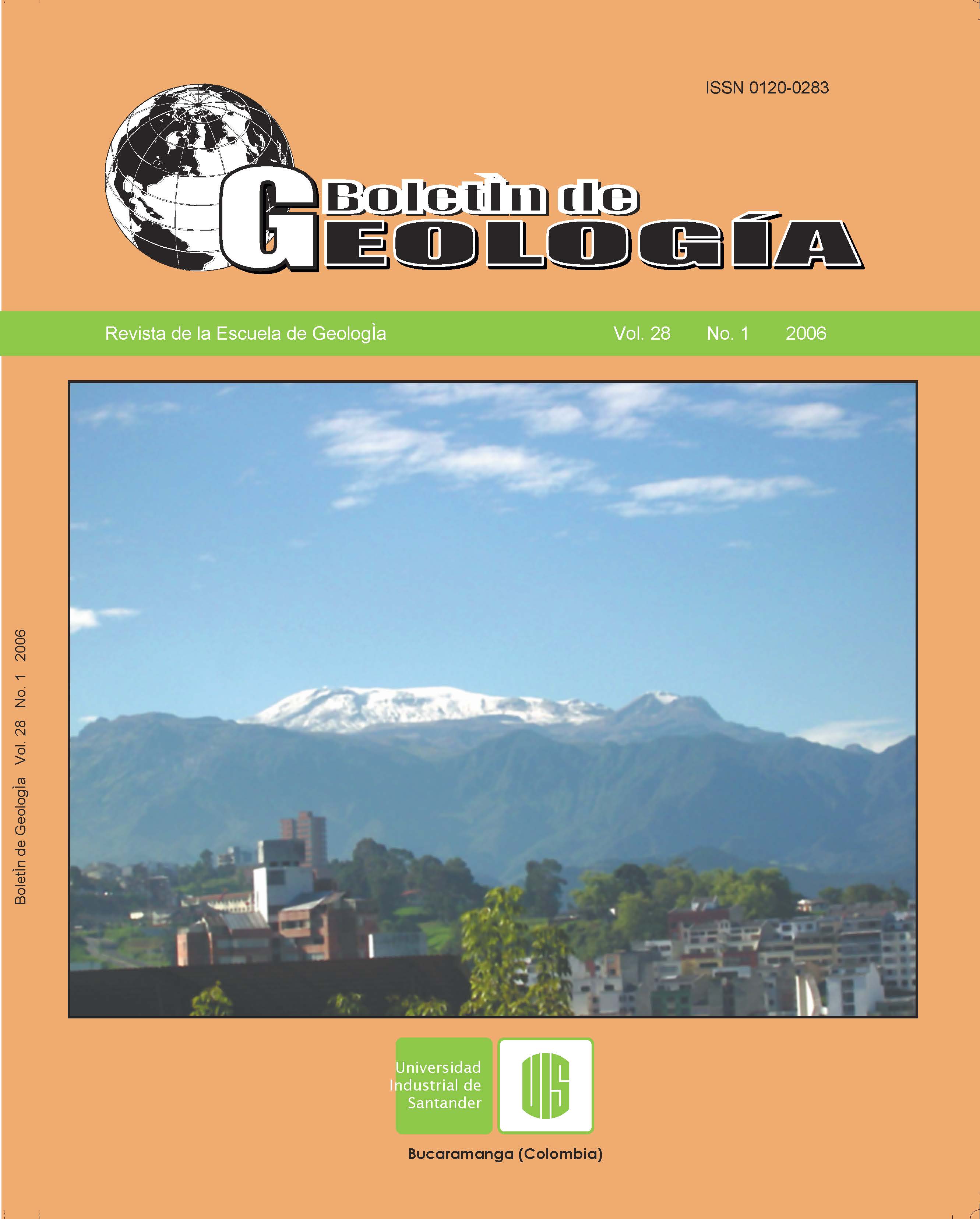ORIGEN DEL DEPÓSITO FREATOMAGMÁTICO DE LA CABAÑA, CUENCA BAJA DEL RÌO CHINCHINÁ, CALDAS-COLOMBIA
Publicado 2013-07-18
Cómo citar
Resumen
El depósito piroclástico de La Cabaña aflora al Oeste de Manizales (Departamento de Caldas, Colombia), entre los RíosChinchiná y Guacaica en la zona de La Cabaña, Tres Puertas y La Manuela, en un área de aproximadamente 6 Km2. Ladistancia aproximada recorrida por la corriente de densidad piroclástica que lo generó desde la probable fuente, el VolcánNevado del Ruiz, hasta el Río Cauca (probable límite de la zona de influencia del flujo) es de 50 Km.; esta corriente presentóun alto grado de fluidización y un comportamiento dinámico turbulento de una fase menos densa de la corriente piroclástica,lo cual evitó su confinamiento a lo largo de los valles de los drenajes principales. Comparando los resultados de losparámetros del software SFT, fracción (k) y del factor de fragmentación (φm/γ) contra la moda de cada subpoblación de éstedepósito, se concluye que todas las subpoblaciones se ubican en el campo freatomagmático, según gráficos presentados porWohletz (1983), y aunque éste es el principal mecanismo de fragmentación no involucra volúmenes de agua importantes. Seencontró que la tendencia de la moda con respecto al factor gamma, promedio ponderado de la dispersión entre la TobaNapolitana Amarilla (Campi Flegrei, Italia) y el depósito piroclástico de La Cabaña son muy similares, lo que induce apensar en un origen común asociado con una caldera, propuesta que se puede relacionar con los resultados de Londoño &Sudo (2002) donde una estructura caldérica es predefinida en el volcán Nevado del Ruiz. La creciente acumulación de grandescantidades de gas en algunas áreas (especialmente alrededor del Cráter Arenas-Volcán Nevado del Ruiz) a profundidadessomeras puede producir la inestabilidad del sistema volcánico–magmático– hidrotermal y podría disparar erupciones freáticaso freatomagmáticas, similares a las que originaron el depósito piroclástico de La Cabaña.
Palabras clave: Caldera, corriente de densidad piroclástica, freatomagmatismo, Volcán Nevado del Ruiz.
Descargas
Referencias
Deino, A.L., Orsi, G., de Vita, S. and Piochi, M. (2004).The age of the Neapolitan Yellow Tuff caldera-formingeruption (Campi Flegrei caldera – Italy) assessed by 40Ar/39Ar dating method. Journal of Volcanology andGeothermal Research, Vol. 133, pp. 157-170.
Gigenbach, W.F., García, N., Londoño, A., Rodríguez,L., Rojas, G. and Calvache, M.L. (1990). The chemistryof fumarolic vapor and termal spring discharges fromthe Nevado del Ruiz volcanic-magmatic hydrothermalsystem, Colombia. Journal of Volcanology andGeothermal Research, Vol. 42, pp. 13- 39
Gladstone, C., Ritchie, L.J., Sparks, R.S.J. and Woods,A.W. (2004). An experimental investigation of density-stratified inertial gravity currents. Sedimentology, Vol.51, pp. 767-789
Londoño, J.M. and Sudo, Y. (2002). Velocity structureand a seismic model for Nevado del Ruiz Volcano(Colombia). Journal of Volcanology and GeothermalResearch, Vol. 119, pp. 61-87
Naranjo, J.L., Borrero, C.A., Ancochea, E., Fuster, J.M.,Grand, M. y Handszer, A. (1991). Los flujos piroclásticosde Río Claro-Chinchiná y su dinámica de emplazamiento.Simposio sobre Magmátismo Andino y su MarcoTectónico, Tomo I, Manizales, pp. 247-264
Ospina, J.C. y Parra, Y.A. (2004). Caracterizacióngeológica de los depósitos volcanogénicos del áreacomprendida entre La Cabaña y Tres Puertas(Manizales). Trabajo de Grado. Universidad de Caldas,Manizales, 89 p
Raue, H. (2004). A new model for the fracture energybudget of phreatomagmatic explosions. Journal ofVolcanology and Geothermal Research, Vol. 129, pp. 99-108.
Schaefer, S.J. (1995). Nevado del Ruiz Volcano Colombia:magmatic system and evolution. Thesis Degree of Doctorof Philosophy. Arizona State University, Arizona. 147 p.
Villegas, H. (2001). Imaging Notes, September-October2001, Educating Policy Makers about Volcanic hazards,<http://www.imagingnotes.com/sepoct01/villegas.htm>
Wohletz, K.H. (1983). Mechanisms of hydrovolcanicpyroclast formation: grain-size, scanning electrónmicroscopy, and experimental studies. Journal ofVolcanology and Geotermal Research, Vol. 17, pp. 31-63
